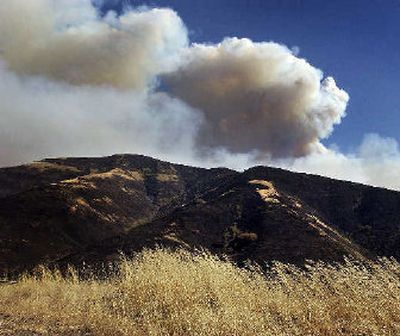Fire leaves its impact

Forest and range fires have displaced wildlife and altered hunter plans in some locations throughout the Inland Northwest.
Fires continue to burn in portions of Idaho and Montana, including the Bob Marshall Wilderness. But hunters also will have to deal with the aftermath of fires extinguished weeks ago. For example:
In the Blue Mountains, several popular hunting, camping and trailhead access areas as well as some roads on the Umatilla National Forest Pomeroy Ranger District have restrictions following the School Fire that raged across 52,000 acres in August. The fire was caused by a downed powerline.
Forest Road 42, Forest Road 4206, Tucannon Campground and trailhead, Ladybug Campground, Panjab Campground and trailhead and Meadow Creek trailhead have had restrictions for safety purposes and some other areas have been open only in daylight hours.
“ For updates, contact the Pomeroy Ranger District office, (509) 843-1891.
The Wooten Wildlife Area, managed by the Washington Fish and Wildlife Department, was in the heat of the School Fire. As a safety measure, the state has banned off-road travel on the 11,778-acre area and closed eight of the Wooten’s campgrounds until further notice.
However, the Tucannon River Road running through the Wooten, three posted campgrounds above Camp Wooten, eight man-made fishing lakes and fishing access to the Tucannon River remain open.
The safety situation will be reassessed weekly and further access might be allowed later this year, department officials said.
“ For updates, contact the Spokane Region office, 892-1001.
No major loss of wildlife has been observed in the wake of the fires, said Kevin Robinette, department regional wildlife manager. Aerial and ground surveys showed that elk and bighorn sheep herds simply moved out of the way of the fires.
Elk that were in the heavily burned north half of Tucannon Unit 166 moved to the edges of the burn and into the unburned south end of the unit, biologists say.
No hunting seasons were changed because of the fire, but the department is already making contingencies for emergency winter elk feeding if necessary, Robinette said.
“And we’ve lost 13 miles of elk fence that keeps elk off private agricultural land, and that’s going to be a challenge this winter keeping elk off the crops,” he said. “Fixing elk fence is spendy.”
The Swanson Lakes Wildlife Area and adjoining private land and Bureau of Land Management land in Lincoln County lost about 5,000 acres to fire this summer. The fire burned on the eastern edge of the wildlife and along Telford Road into a BLM area that was just secured an opened to the public last year.
“The fire displaced the deer to a certain extend, but they’ll move back in when we get some rain and it greens back up,” said Todd Baarstad, Washington Department of Fish and Wildlife habitat specialist who lives in the area.